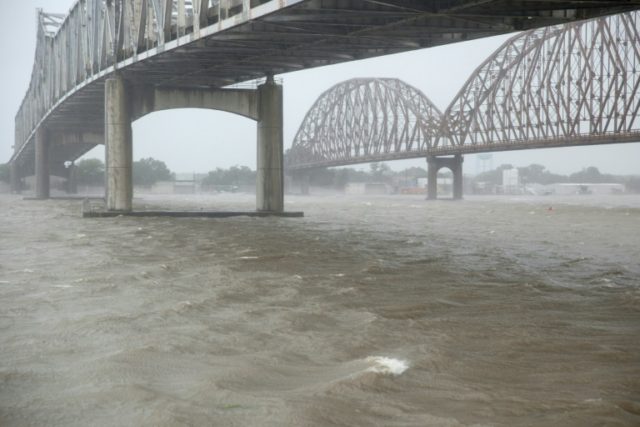Intracoastal City (United States) (AFP) – Major storm Barry slammed into Louisiana on Saturday, pelting the region with heavy rain and ferocious winds as millions of Americans braced for the serious flooding expected to follow.
After briefly becoming the first hurricane of the Atlantic season, Barry was downgraded to a tropical storm after making landfall — but it nevertheless packed a serious punch as it moved inland.
All flights in and out of the airport in the state’s biggest city New Orleans were cancelled, thousands had evacuated their homes, tens of thousands had lost power and first responders were poised for action.
Fears that the levee system in New Orleans could be compromised had eased after the Army Corps of Engineers voiced confidence that it would hold, but Mayor LaToya Cantrell urged residents not to be complacent.
“We are not in any way out of the woods,” she said, adding that flash flooding could still occur into Sunday.
At 4:00 pm (2100 GMT), the storm was packing winds of 65 miles (100 kilometers) per hour, the National Hurricane Center said, and was located near the city of Lafayette, moving north-northwest at seven mph.
“Much of the rain associated with Tropical Storm #Barry this weekend over Louisiana and Mississippi will be lagging behind the center of the storm,” the National Weather Service said in a tweet.
Heavier rain was expected late Saturday, spreading north on Sunday, with 10 to 20 inches (25 to 50 centimeters) in the forecast.
In St. John’s Parish next to New Orleans, some areas were already under two or more feet (60 centimeters) of water, local television footage showed.
“The people of Louisiana are resilient, and while the next few days may be challenging, I am confident that we are going to get through this,” Governor John Bel Edwards said.
– Cajun Navy –
The eye of the storm made landfall at Intracoastal City, a speck of a town with a few houses and businesses. Part of the main road was flooded Saturday afternoon, as were some waterfront businesses, with water rising by the minute.
News footage showed localized flooding, swollen waterways, and downed power lines and trees across south Louisiana as rivers overtopped their levees in several locations, including part of coastal Terrebonne Parish where authorities had issued a mandatory evacuation notice.
The Atchafalaya River had swallowed the waterfront pedestrian prominade in Morgan City, which was entirely without power, as about 10 members of America’s Cajun Navy citizen rescue group assembled under a highway overpass.
“We’re just neighbors helping neighbors,” John Billiot, 39, the group’s president, told AFP.
They have been conducting volunteer rescues since Hurricane Katrina in 2005, and were equipped with five flat-bottom rescue boats, a high-clearance, military-style truck and 86 boats staged in the region in preparation for the latest storm.
“We’re still waiting. Barry is playing peek-a-boo with us,” Billiot said.
For many, the storm and potential for large-scale flooding revived unpleasant memories of deadly Hurricane Katrina.
Thousands have packed up and left their homes as floodwaters hit low-lying areas like Plaquemines Parish, where road closures left some communities isolated.
Others hunkered down to ride out the squall, despite mandatory evacuation orders and the risk of dangerous storm surges.
“Category one, I’d say, is not much to worry about. A one? That’s a thunderstorm. I’ll be back to work Monday,” William Manuel, a maintenance worker living in Bayou Vista, not far from Morgan City, told AFP.
– Dangerous conditions –
Louisiana is facing an extraordinarily dangerous confluence of conditions, experts say.
The level of the Mississippi River, already swollen from historic rains and flooding upstream, was at nearly 17 feet (5.2 meters) in New Orleans — just below flood stage.
River levels are expected to peak at just over 17 feet, according to Saturday’s forecast by the National Oceanic and Atmospheric Administration (NOAA).
US Senator Bill Cassidy said officials with the Army Corps of Engineers told him they were “confident” that the 20-foot-high levee system protecting New Orleans, a city of 400,000, would hold.
“There’s still going to be two to three feet between the top of the levee and the top of the floodwaters,” Cassidy told Fox News.
In 2005, Katrina — the costliest and deadliest hurricane in recent US history — submerged about 80 percent of New Orleans after the city’s levee system failed, causing some 1,800 deaths and more than $150 billion in damage.
bur-mlm-sst-acb/cs

COMMENTS
Please let us know if you're having issues with commenting.